


| 4. EXPOSURE CRITERIA FOR STEREO PHOTOGRAPHS |
| 4.1 The photographic base |
The exposure criteria follow directly from the general viewing conditions (3).
The lens separation or base should ideally be equal to the separation of the eyes, the standard of 63.5 mm.
If one photographs with this normal base and with
a focal length (equal to the picture's diagonal), a space with depth expansion
of 2 m as the near-point distance and infinity as the far-point distance, a
result of ![]() is obtained as the difference
between the near-point separation and the far-point separation on the picture
plane (on the film). The difference
is obtained as the difference
between the near-point separation and the far-point separation on the picture
plane (on the film). The difference ![]() is also called deviation or on-film parallax.
is also called deviation or on-film parallax.
One can therefore conclude that every stereo photoqraph,
where this near-point/far-point separation difference ![]() is not or only slightly transgressed, can be viewed without any problems and
that no trouble with fusion or blurring will occur.
is not or only slightly transgressed, can be viewed without any problems and
that no trouble with fusion or blurring will occur.
The ratio between the base of 63.5 mm and the near-point distance of 2 m is approximately 1 : 30. Deduction and Fourth Stereo Rule: The base or the lens separation should be 1/30 of the near-point distance.
The formula for this, which is given later, is not totally linear. Therefore this value of 1/30 for the base is valid only for near-point distances down to approximately 30 cm.
The deviation is not a constant. Its size depends
on an individual's stereo viewing ability. Whose who seldom view stereo photographs
often encounter problems with this. After viewing for a short time, it becomes
effortless. Photogrammeters who often work with stereograms can easily view
pictures with a larger deviation. Their eyes are just better trained. For amateur
35 mm stereo pictures 2x 24 x 23 mm and 2x 24 x 29 mm one can set ![]() = 1.2 mm. For the format 2x 6 x 6 cm (6 x 13)
= 1.2 mm. For the format 2x 6 x 6 cm (6 x 13) ![]() = 2,8 for a focal length f = 85 mm. If you correctly understood the previous
material you know that the deviation depends on the choice for the distance
of the stereo window and on the normal focal length used. These values correspond
with the 1/30 rule.
= 2,8 for a focal length f = 85 mm. If you correctly understood the previous
material you know that the deviation depends on the choice for the distance
of the stereo window and on the normal focal length used. These values correspond
with the 1/30 rule.
In stereo literature the value for the ratio base/near-point
distance is often given as 1/50 (0.02) and a 70'-condition is discussed. In
English speaking countries the value of 1/30 is clearly preferred. With a value
of 1/50 the stereo window lies at 3 m. That means that space is literally given
away. On the other hand, it is not necessary to stop-down as far. The 70-minutes
condition is based on a theoretical error and is heavily debated. It deals with
an angle ![]() = 70 minutes of arc (fig.
4.1).
= 70 minutes of arc (fig.
4.1).
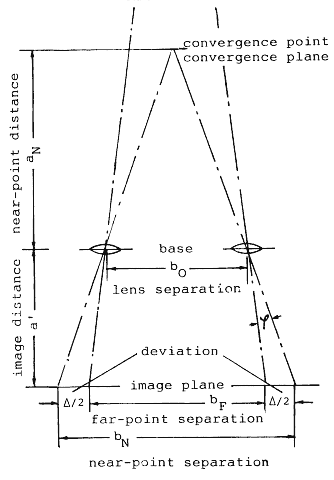
|
Explanation of terms Distance is the range between the camera and the object to be photographed in the direction of the optical axis. Separation is the range between corresponding points perpendicular to the optical axis, e.g., on the film. |
||||||||||||||||||||||||||||||||||||||||||||||||||||||||||||||||||||||||||||||||||||||
|
|
The plates of the graphs depicting the photographic
base necessary for stereo exposures stem from a formula derived later (chapter
9) and from the assumption that ![]() is held constant. Graph 1 (section "Graphs") shows that in a close range distinctly
different values hold for the different picture formats and corresponding normal
focal lengths. With longer focal lengths this also holds for a larger near-point
distances and is of no consequence for the amateur.
is held constant. Graph 1 (section "Graphs") shows that in a close range distinctly
different values hold for the different picture formats and corresponding normal
focal lengths. With longer focal lengths this also holds for a larger near-point
distances and is of no consequence for the amateur.
Graph 2 holds for users of single lens reflex cameras with interchangeable lenses with a 35 mm format, and graph 3 holds the same for 6 x 6 -cameras. Special reference is necessary to the fact that the required base may only be determined from the near-point distance and not from the depth of space to be depicted. It must be adjusted for by the aperture in conjunction with the depth-of-field-scale on the lens. In graphs 1 and 2 it is interesting to note that the base and the enlargement factor are closely related. If one employs a set enlargement factor in close-up photography, the base is then also fixed, independent of what focal length is being used. Naturally the near-point distance or the focus distance changes.
When considering the values for the base taken from the graphs the camera does not have to be toed-in.
The sketch in figure 4.2 shows why one must reduce
the base, i.e. the lens separation, when one wants to take distortion free stereo
close-up photographs with parallel lens axes. The value for ![]() should be held constant.
should be held constant.
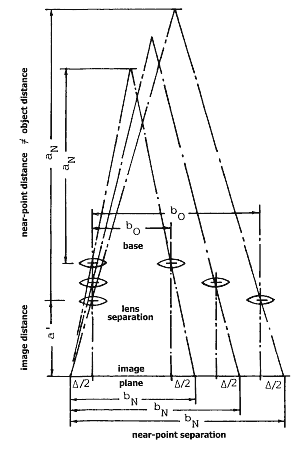
|
|
|
| 4.2 Depth of field |
From every modern camera one can read the depth of field directly from a scale located at the focus adjustment. Depth of field is dependent on the chosen aperture and grows as the aperture gets smaller (larger aperture values: the ratio is always 1 : aperture number!). When the focus is set for a far distance the frontal depth is always smaller than the back depth, which approaches infinity. Depth of field, however, drops off rapidly with small distances and becomes almost symmetrical (front depth approximately equal to the back depth), for example, with an aperture of 22 and an enlargement factor of 1 : 1, it approaches 2.6 mm.
Depth of field, just like the photographic base, when examining in terms of the enlargement factor, is independent of the focal length. Therefore it is suggested to work from the enlargement factor when taking macro or micro stereo photographs because the everything, including the factor for the exposure time, is already determined.
For that reason, graph 4 shows the depth-of-field
for the macro and micro regions, the stereo base for ![]() = 1.2 and 3 mm and the exposure factor dependent on the enlargement factor.
In practice one will first determine how much depth of field one requires for
the picture in mind, e.g., 5 cm. Then, from graph 4, one has the choice between
an enlargement factor of 0.04 with aperture 1.4 and 0.22 with aperture 32. A
predetermined enlargement factor of, e.g., 0.15 results in an aperture of 16
and, with
= 1.2 and 3 mm and the exposure factor dependent on the enlargement factor.
In practice one will first determine how much depth of field one requires for
the picture in mind, e.g., 5 cm. Then, from graph 4, one has the choice between
an enlargement factor of 0.04 with aperture 1.4 and 0.22 with aperture 32. A
predetermined enlargement factor of, e.g., 0.15 results in an aperture of 16
and, with ![]() = 1.2 for a 35 mm format,
a base of 8 mm and an exposure factor of 1.35. From graph 2 we can determine
that this corresponds to a near-point distance of 40 cm with a focal length
of 50 mm. This yields a focal distance of 42 cm. On the other side, a normal
base of 65 mm would correspond to an enlargement factor of approximately 0.02.
That provides, for example, a depth-of-field of 55 cm with an aperture of 2.8.
= 1.2 for a 35 mm format,
a base of 8 mm and an exposure factor of 1.35. From graph 2 we can determine
that this corresponds to a near-point distance of 40 cm with a focal length
of 50 mm. This yields a focal distance of 42 cm. On the other side, a normal
base of 65 mm would correspond to an enlargement factor of approximately 0.02.
That provides, for example, a depth-of-field of 55 cm with an aperture of 2.8.
| 4.3 Deviations from the ideal Case |
One can take close-ups with a small base
by toeing-in mono cameras upon the close-up object or - this was possible
with old stereo cameras - move the lenses toward each other (still possible
today with old plate cameras). One can also mount stereo simple prisms,
usually in form of glasses, in front of the lenses of a stereo camera,
thereby converging the lens axes onto the close-up object (fig. 4.3). These
prisms can also be manufactured as close-up lenses which enable one to
get even closer to the object. Special tables are then necessary to focus
because the reduction in focal length causes the distance scale on the
camera to be incorrect. In addition, the viewfinder is off and the entire
operation is more or less hampered by much distortion. If one works with
two coupled cameras, one seldom achieves a base that corresponds to the
normal eyes separation or to the values taken from the graphs. this excessively
large base causes the space to appear smaller than it actually is. If this
effect is noticeable, one speaks of a model or doll house effect. This
Effect is called lilliputism. The a base is called giantism. It leads to
the effect that the space looks larger than it really is. In practice we
hardly ever have to deal with this case.
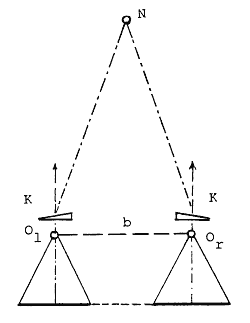
|
|
|
In the ideal case, the optics within the
viewer should have the same focal length as was used during exposure. A
longer focal length of the viewing lenses leads to an exaggeration of the
depth, whereas too short a focal length produces the opposite effect (fig.
4.4). It so happens that a larger base and a smaller viewing focal length
partly cancel each other out. On the other hand, experiments with test
subject have shown that stereo pictures taken with a bigger base were preferred
as being more "natural" by their viewers.
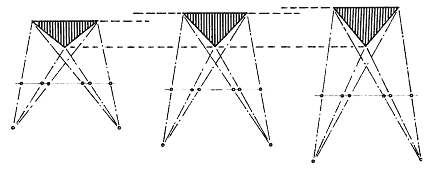
|
|
Changing the spatial impression through different focal lenths of the viewing optics |
If the base becomes excessively large the picture may seem to "fall apart". Such stereo pictures cannot be viewed and causes headaches.
From the formula for the base it also follows
that when one uses the longer focal length of a telephoto lens, a smaller
base is needed and vice versa. In figure 4.5 this is easily demonstrated.
Owners of cameras with interchangeable lenses should work with short focal
lengths when photographing with coupled cameras.
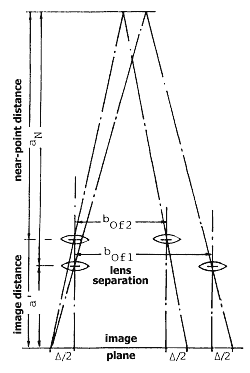
|
|
|
All the preceding considerations and the
calculations of the stereo base assume that the lens axes are parallel,
because only this results in undistorted pictures. But in some cases, the
dimension of mono camera do not allow bringing the axes as close together
as wanted. Then the use of front coated mirrors can help to deviate the
beam at 90°. But the smallest base depends always on the dimension
of the cameras, as shown in figure 4.6 and 4.7. One needs only one mirror
(fig. 4.6), but then one single view is reversed to the other.
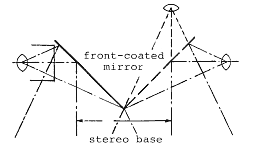
|
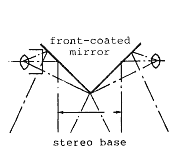 |
|
|
|
If one does not want to take so many pains,
or when the mono cameras are still to large, the only alternative left
is to converge the axes of the cameras. One must converge on the near-point
of the object (fig. 4.8). Then the stereo window plane equals to the convergence
plane. But remember: The closer the near-point distance, the bigger the
distortions. With two coupled normal 35 mm cameras one gets a base of about
12 - 15 cm, twice as big as the normal stereo base. So the smallest near-point
distance should not be closer than 3 m.
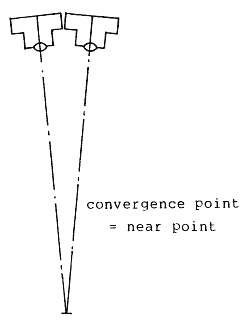
|
|
|
As one can deduce from the above, one does
not have to be "stingy" with the base. In the normal practice of amateur
stereo photography, one will not notice photographs which are not exactly
spatially correct, or not true in scale. This is for simple reason that
the scale is missing. Therefore depth cues are often used as element of
professional stereo photographs.
| 4.4 The time criterion |
In 3.2 it was mentioned that identical or homologous points in the picture should always lie on the same horizontal. They must, however, also conform to the entire perspective conditions. This is only the case when both single views are synchronously exposed. If not, then a shift of position of the moving object appears in the "later" exposed picture.
If one takes stereo photographs with one mono camera with the aid of a shifting device or attachment to move the camera in a parallel manner, the single views must naturally be exposed one after the other. The light source, usually a flash, must not be attached to the camera, otherwise the "sun" moves between the two exposures, and disruption occurs in the shadows of the picture.
The degree of synchronisation depends on the speed of the moving object being photographed. A slow pedestrian naturally allows for larger tolerances than does a speeding race car.
Focal plane shutters must be carefully
synchronized, especially when photographing with a flash. It can then happen
that one part of one of each view is all or partially covered by the shutter.
Diaphragm shutters can cause underexposure of a single view since when
not fully open, they act as an aperture. From the above follows the Fifth
Stereo Rule: With one mono camera only stereo exposures of fixed objects
in short succession may be made. Drifting clouds or rustling leaves
may already lead to distortions and disruptions.
| 4.5 Stereo attachments: A means to close-ups |
One classifies stereo attachments into two types. The first type is placed on twin-lenses as in figure 1.3d in order to increase the base. The other type works as a beamsplitter, with which one can take stereo photographs with normal single lens cameras (fig. 1.3f). Both have the limitation that the attachment must be set exactly horizontal on the camera. The picture's image area is divided into two equal parts with a dividing line of approximately 1 mm (fig. 4.9).
There is nothing special to mention concerning
the first type: it has the characteristics of a normal stereo camera and
works only as base spreader. Its pictures lie correctly side by side on
the film as in a true stereo camera, while the beamsplitter's pictures
are interchanged.
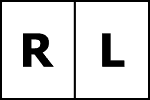
|
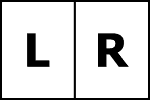
|
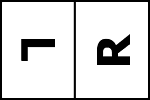
|
|
|
||
|
base spreader |
beamsplitter |
|
|
|
|
|
|
|
||
For viewing these uniquely achieved pictures, corresponding viewing equipment is required. With beamsplitters two different principles are employed. The first gives vertical format pictures that stand side by side, while the second produces pictures in a horizontal format with the top edges of each adjacent to the top of the other.
One makes a distinction between beamsplitters
that divert and those that detour the beam. The beamsplitter producing
the horizontal format was manufactored under the name of "TRI-DELTA" by
the American company TRI-DELTA Engineering and is of the type that detours
its beam. As one can see from figure 4.10, the path of the beam is almost
bent by 90° which leads to an unusual camera positioning. To aid in
aiming the camera, a telescopic viewfinder was installed in the attachment.
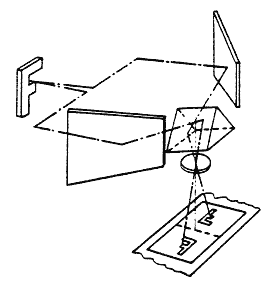
|
|
|
The beamsplitter with a normal, diverted
beam path is available, or was available, with two different base lengths.
The normal model has a base length of 65 mm (fig. 4.11b) for an effective
photographing range of ' - 0.8 m. (Only the attachment from ASAHI-PENTAX
is currently still available.) In addition, a special edition of a diverting
double prism (from Wenham was available (fig. 4.11c) with a base of 12
mm for an effective photographing range of 2 - 0.15 m. Sometimes available
is the STITZ stereo attachment with adjustable mirrors and apertures for
a focal length range of 50-300 mm. It allows convergence at different distances
and can therefore also be used for close-ups.
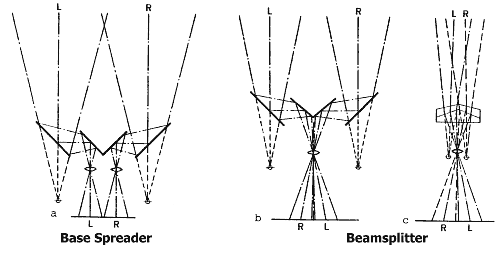
|
|
|
The normal beamsplitters are all constructed
for normal 35 mm cameras with lenses of a focal length of approx. 50 mm.
Therefore they function only with lenses of that focal length. An exception
is the 65 mm attachment from Zeiss-Ikon (I do not know if the other brands
also work: I measured it with the Zeiss-Ikon attachment. I did the experiment
with the short base attachment from Zeiss-Jena and with the Tri-Delta.
It did not work). Figure 4.12 shows the range in which one can combine
other focal lengths with the Zeiss-Ikon attachment. This attachment is
intended for a focal length of 45 mm. The measurements were conducted with
a 50 mm Tessar. A setting of ' creates a far-point separation of 21.5 mm
on the picture plane of both of the single views. The near-point separation
may then be 19 mm to the middle separation of the single views or else
the near-point enters the stereo window. This measurement is attained by
a distance setting (image plane - object plane) of 0.8 m.

|
|
|
All picture settings with these measurements from 21.5 to 19 mm are therefore possible. A focal length of 100 mm has proven to be a practical limit. That results in an enlargement factor of 1.3. At a focal length of 110 mm, an enlargement factor of 2.4 results. For that purpose, bellows of a length greater than 350 mm at a distance setting of 0.5 m are already necessary. The camera and bellow should be mounted at the center of gravity. Also consider that, with an enlargement factor of 1 or 2,, an exposure factor of 4 or 9 is necessary.
Since this construction is the only way
to take stereo close-ups of moving objects, it is worth the effort. One
should, however, use a flash, a circular ring flash if possible.
| 4.6 Practical hints |
We learned in section 3.2 that stereo pictures may not contain any vertical parallax. It is therefore worthwhile to mount a small spirit level on the camera, or even install it in the viewfinder. I have, for example, installed a small spirit level on he masking plate of an old Zeiss-Ikon viewfinder, so that it is reflected in the image. Sixth Stereo Rule: The camera may be not set at an angle if one wishes to save a considerable amount of time during the mounting of the picture, or the lens axes are not to be revolved.
A little tilting or inclination (pitch)
of the lens axes of the camera is allowed. The falling lines do not usually
distract as much as they do in a flat picture. When one views these stereo
picture in the stereoscope, one can even restore the "original" spatial
impression by raising or lowering the head so as to find the correct angle
at which the photograph was taken.
| 4.7 Drawn stereo pictures |
By conforming to the previously mentioned
conditions, the single views can also be drawn or painted (Dali). They
are usually printed side by side or one on top of the other as anaglyphs
(see chapters 5.2 and 7). Do it as the animated effect film producers do:
draw on multi-layer transparent sheets, one for each depth plane. When
the first single view is finished, make a copy of it. Then shift the different
layers one against the other to create the deviation needed between the
near-point plane and Zeiss-Ikon Stereo Attachment the far-point plane.
Remember: The maximal deviation depends on combined with lenses of different
focal lengths the size of your drawing. Experience makes wise!
| Previous
Chapter: General requirements for the Stereo Picture |
Contents |
Next
Chapter: Viewing Requirements for Stereo Photographs |
 |
|

| Back to the Services Page |
